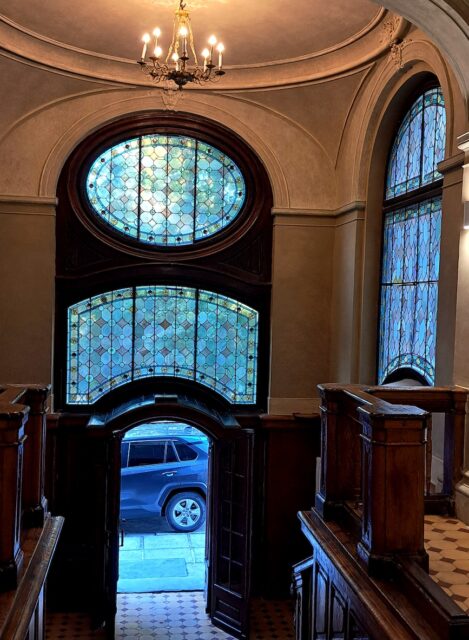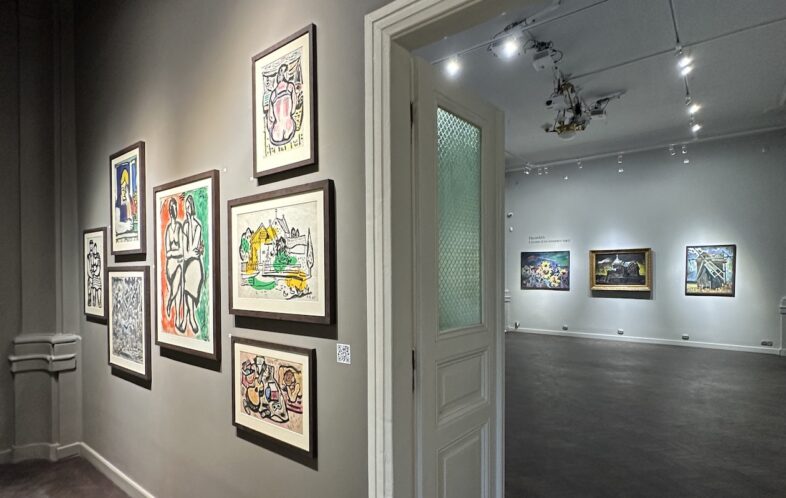Following the Russian full-scale invasion in February 2022, many Ukrainian museums dedicated to individual artists found their once-vibrant memorial spaces rendered starkly empty as collections were moved into storage and display left bare. In response, curators have sought inventive ways to sustain the artists’ legacies. Some have staged temporary exhibitions, recontextualising works thematically, while others have organised events with documentaries, virtual tours, and lectures. A number of institutions have embraced digital technology, digitising their collections to ensure continued access. Meanwhile, some museums have opted to remain closed, preserving their artefacts for a more stable future.
In the neighbourhood where the Patyk Museum opened last week, the density of memorial museums is arguably the highest in Lviv and surpasses that of other regional centres in the country. Situated near St. George’s Hill, this area seems to have fostered a distinctive artistic environment linked to the legacy of 20th-century artists. It is in the museums of Oleksa Novakivskyi, Olena Kulchytska, and Leopold Levytskyi that one can witness the evolution of Ukrainian modernism—a visual and intellectual counterpoint to oppressive authoritarian regimes. The rapid opening of another museum in this artistic enclave, dedicated to yet another notable modernist, represents both a commendable and somewhat risky venture, particularly amidst the frequent air raid alerts.
Although I nearly used the term ‘memorial,’ the Patyk Museum at 4 Mateyka Street defies the conventional Soviet-era museumification we inherited from the 20th century.

To begin with, the team behind the museum’s concept decided to restore part of the Potulitsky-Lininsky villa, built at the end of the 19th century by Ivan Levynskyi’s firm, rather than preserving it in the condition the artist might have seen during his lifetime. This decision—to remove all the residue of the Soviet era that had seeped into the walls, wooden stairs and parquet flooring, ceramic tiles, and stained glass—was made to reveal the colourful and textured elegance of the grand entrance. Undertaking this project just three months before the announced opening while simultaneously organising the exhibition, preparing the brochure, and developing merchandise was, of course, very risky. It almost resembles the Soviet-era ‘storming’ approach that the era of ‘developed socialism’ loved to orchestrate around specific celebratory dates.
The team brought in by the museum staff—exhibition curator Pavlo Hudimov, who was in daily contact with future museum staff, identity developers, designers, specialists from the restoration firm KARP Restorer, and consultant Volodymyr Kostyrko—carried out restoration, conservation, finishing, and design work with remarkable intensity and impact. This success was largely due to the use of cutting-edge technologies, including surface cleaning with a specialised laser installation, the restoration of missing elements based on blueprints and photographs, and precise toning. As a result, visitors can experience the aesthetic history of the building—a space where Volodymyr Patyk never lived and which he did not document in his work. Yet its restored appearance compellingly reveals why the artist was so deeply distressed by the Soviet-era cityscape.
In 2023, Romana Vasylivna, as the heir to the artist’s legacy, generously donated one hundred works, along with archival photographs and personal belongings, to the people of Ukraine. Most of these items are now displayed across several rooms of the museum, which collectively cover approximately 200 square meters. Rather than following a chronological order, the works are presented thematically, reflecting the central themes and genres that preoccupied the artist throughout his life. Visitors will encounter both well-known, almost canonical paintings and surprising discoveries, such as graphic compositions that invite further exploration within the context of the Lviv graphic school of the late 20th century. One of the museum’s most compelling spaces is the so-called ‘final’ room, which recreates the artist’s workshop, studio, or workroom.
This is not a mere replica of any of the artist’s original workspaces but a metaphorically recreated atmosphere. Behind a screen, we find a mannequin, while a display case showcases a palette with brushes, notebooks, paints, and sticks. Nearby, a cupboard holds ceramics, and chairs and extensive informational stands are scattered throughout, interspersed with works—lots of works. Every wall is utilised for a ‘wallpaper’ display of these artworks, creating a dense tapestry of images and objects that acts as a striking counterpoint to the absence of windows. The tight, almost claustrophobic nature of this room, in contrast to the museum’s other spaces, symbolises the spatial and existential constraints that dominated Patyk’s life.

The museum entrance, in stark contrast, is spacious and elegant, allowing for an open ascent. Yet beyond it lies a near cage-like environment, echoing the constraints the artist overcame through his work, often defined by dominant black contours. Also on display is a sculptural portrait of the artist by Yaroslav Motyka, strategically positioned at chest height for visitors. It is illuminated to highlight its ivory tones without glare, drawing the viewer in much like the inviting keys of a piano.
The musical theme resonates throughout the museum, permeating rooms both with and without large windows. We encounter jazz improvisations on stage and in a café, a melody from a whistle near a three-branched candlestick on a Lviv apartment’s windowsill, and a guitar set among relaxation items on a beach—all vividly rendered on canvases and in drawings. These works are thoughtfully illuminated by a modern lighting system, which creates a striking contrast against the grey, wet-asphalt-coloured walls. This asphalt, reminiscent of the material widely laid in the 1960s and 70s, replaced the city’s old cobblestones, obscured village paths, and even dismantled the wings of windmills.
The museum itself, more than just its exhibition, is a testament to contrasts and the sharpness of oppositions, reflecting the angularity and emotional intensity of the artist’s visual language. Visitors can wander through the meticulously designed rooms, peruse an extensive brochure, or request to activate visual mapping to explore an additional narrative layer about specific works and the overarching themes of Patyk’s oeuvre. This approach seamlessly intertwines three centuries: the elegant space of the 19th-century villa, the raw energy of 20th-century modernism, and the precise technological accents of the 21st century.
For the first time in thirty years, following Borys Voznytsky’s realisation of his vision with the Museum of Baroque Sculpture by Johann Georg Pinsel in 1996, Lviv has welcomed a new museum dedicated to an artist. In the midst of the Russian-Ukrainian war, this new space stands as a poignant reminder of the relentless aggression against Ukraine’s cultural heritage in the 20th century and the steadfast personal resistance Volodymyr Patyk mounted through his art. Confronted with the era’s relentless oppression—surveillance, interrogations, and ideological mandates—Patyk defended his identity daily, his genuine emotion cast in the stark, lifeless light of the time.
This event could potentially inspire a shift in other museums—both memorial and otherwise—that are currently hesitant to reopen or refresh their displays. If only the transformative power of creativity could dispel this apprehension, for a nation that continues to open museums even amidst conflict is truly indomitable.

